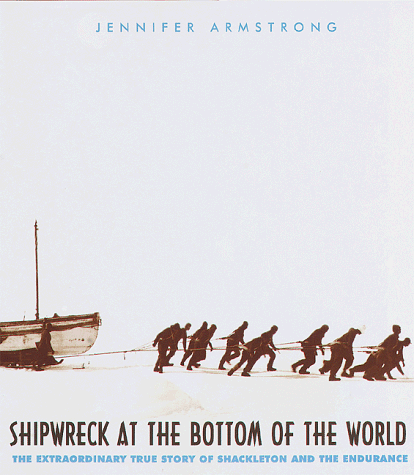
of the World
The Extraordinary True Story of Shackleton and the Endurance
By Jennifer Armstrong
Random House
New York
1998
ISBN 0613301269
Ages 9-12
The story begins in 1914 when Sir Ernest Henry Shackleton sets out to lead an expedition to be the first to cross the South Pole from one side to another. Two previous attempts for him to be the first to reach the South Pole were thwarted by bad weather, and two other men beat him to it. Shackleton planned to take a group of men by dogsled across to the other side where another ship would pick them up. Neither the rescue ship nor Shackleton's group made it. Shackleton's boat, the Endurance, became ice-bound by packed ice before reaching Antarctica. The ship and crew spend the next nine months floating on a huge ice pack until the ship is crushed and sinks. The crew lives on ice floes and are at their mercy the next three months waiting to be able to launch the three lifeboats in the ocean where they could maneuver around icebergs. Their goal is to reach the unhabited Elephant Island at the furthest tip of Antarctica's peninsula-- a needle in a haystack. From there (if they made it), Shackleton planned to launch one small sailing boat to attempt to travel 800 miles over some of the roughest waters on the face of the Earth to the South Georgia Island where a whaling village could hopefully provide a ship to rescue the remaining men on Elephant Island. Impossible!
I honestly cannot see how any of them survived at all through not just one or five or ten harrowing situations, but dozens of life-threatening situations they faced daily. The temperature rarely rose above zero degrees; the men lived in wet clothes and slept in wet sleeping bags fighting the effects of frost bite constantly; the ice floes they lived on were continuing to melt and break apart, or they would freeze in mountainous peaks that made travel over them impossible; they had to worry about killer whales stalking them from below thin ice or leopard seals attacking them on top of the ice; when in the boats, they regularly faced hurricane force winds, huge waves, and the threat of being crushed between ice floes and bergs. I tried not to think about it too much, but they even had to kill the ship's cat and eventually all the sled dogs and puppies, using some for food. Survival mode put them at the level of animals, but they never reached the point of cannibalism like other doomed expeditions did.
The success of their survival was due to a number of things. Shackleton's leadership and his amazing ability to keep his crew (27 men besides himself) emotionally up and mentally prepared was noteworthy. Even more remarkable was his ship captain Worsley's exceptional skill at navigation using a chronometer, compass, and the sun and stars. A lesser skilled man would've doomed the crew to being lost on the ice or the ocean. The cook kept the crews' bodies going by providing warm drink and energy-sustaining foods in the worst possible conditions. Another crew member had the skills to repair, modify, and outrig the lifeboats for the impossible journey through the ice packs and open seas. But I believe God had his hand on this expedition, too, in that not one man was lost throughout this whole ordeal. The same storm that sunk a 500 ton tanker and took the lives of its crew allowed Shackleton's crew aboard three small lifeboats to survive.
The photographs are amazing, and they are only a third of what was actually taken since the majority of them had to be left behind. It would've been hard to believe all that had happened to these men without the photographs, which document so much of what these men experienced. I am so glad these pictures survived along with the men. Those, along with the testimonies of these twenty-eight men attest to the accuracy of the book.
As for the organization of the book, the author covered all the bases: table of contents, bibliography, and extensive index. She even included the original plans of the Endurance, the boat that was eventually wrecked and sunk by the ice pack. Other very helpful illustrations were the two maps of the Antarctica- one of the whole area, and the second of a blow up of the route that Shackleton's crew traveled on this expedition. She even marked where certain events occurred. I found myself referring to it regularly as I read the book. The photographs are amazing and are disbursed throughout the book. At first I didn't consider the book attractive-looking since it had no color illustrations except for the sepia-toned picture on the cover, but as I read the story, that immediately became secondary and the black and white pictures took on a tremendous value. The book was written chronologically, which had a way of taking the reader along with the crew on this expedition.
I don't have an adventurous bone in my body-- especially when the adventure involves danger and the knowledge that many lives were lost previously attempting to go where these men willingly chose to go. It's hard for me to understand what inspires these men to do things like this. But I can also appreciate the fact that people like this do exist. America and other lands would never have been discovered and civilized, and men would never have reached the moon if explorers' hearts like the men in this book had not had the courage to attempt these journeys.
Home